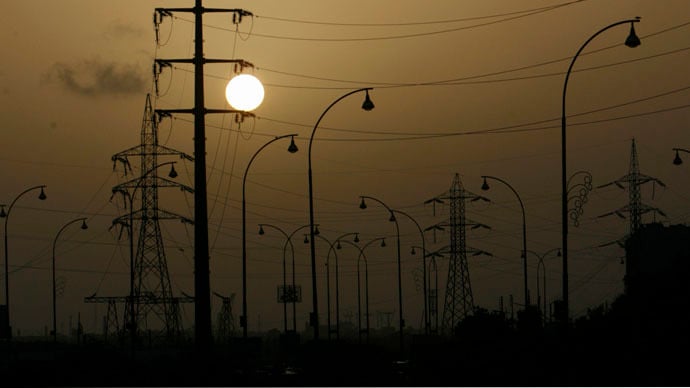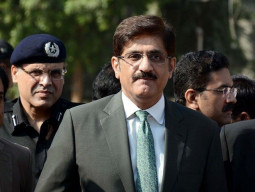
"In my 80 years of life, no one ever paid heed to our calls for electricity," said Jafferani. "We were forced to cool ourselves with traditional hand fans come summer every year. Until now that is."
Deh Je Wandh is one of many villages of Sindh that, driven by years of official neglect, have turned to solar power to meet their electricity needs. During the day, glimmering panels that dot the landscape of small towns and villages in the province can be seen from far away. At night, twinkling lights powered by batteries charged over the day make them appear like bustling urban areas or industrial hubs.
"Solar panels have changed our life so much for the better," a beaming Jafferani told The Express Tribune. "We pray with all our hearts for whoever invented this technology," he said.

Power generation dips 13% in March
As much as 90 per cent of Deh Je Wandh and other adjoining villages are now powered by solar energy, a visit to the area revealed. The residents, when interviewed, revealed that they have invested in the technology out of their own pocket.
"I sold my goat to purchase a solar panel for Rs5,500 and a battery for Rs9,000. A fan compatible with solar power cost me another Rs4,500," said Ali Bux Totani of the neighbouring Thorhi Bijar village. "The battery, after being charged by the panel, powers a fan and two bulbs for 24 hours, which is sufficient for my family of four," he added. "There is no bill at the end and I do not have to suffer hours-long power breakdowns."
Connectivity issues
Both Deh Je Wandh and Thorhi Bijar are located in Kamber Tehsil, where power lines were first laid down under the government of Pakistan Peoples Party founder Zulfikar Ali Bhutto in the 1970s. Even so, up till now, only 50 of the tehsil's 300 households have electricity meters installed and only half of them manage to pay their power bill on time. Roughly the same picture holds true for the more than three dozen surrounding villages that have not seen regular supply of electricity for the last 30 years.
"We used to bear 15 to 18 hours of load shedding every day," said local landlord Abdul Malik. "And that was on the days we had electricity at all. Often times, we had to live without it for days."
"Now, virtually entire villages have switched to solar power," Malik said. "I purchased two panels for Rs11,600 and a medium-sized battery for Rs13,800. The battery charger, cabling and convertor cost me Rs7,000. I can run four fans and four bulbs using this setup. I will be getting two more panels to power a fridge," he added.
Delay to fill vacant posts in energy firms may cause power crisis this summer
Demand and supply
"Six years ago, I sold a single solar panel for Rs14,000," said Ishaq Soomro, a supplier of solar energy equipment in Kamber tehsil. "Now, the huge demand for solar energy and competition to meet it means a panel costs a mere Rs5,500," he told The Express Tribune.

According to Soomro, solar energy is being relied on not just for fans and lights, but heavy power consuming appliances like air conditioners as well. "You need six solar panels to run air conditioners, which can be installed for Rs180,000," he said.
"Almost everyone here now relies on solar energy because the local power utility company has failed them," Soomro added. "Even basic health centres run by PPHI (People's Primary Healthcare Initiative) and government schools in our district are switching to it."
Beyond Larkana, villages and towns in Kamber Shahdadkot, Dadu, Sanghar, Jamshoro, Kashmore, Sukkur, Shikarpur, Jacobabad, Khairpur, Thatta and Badin districts are also increasingly opting for solar energy.
But it is not only rural areas that are turning to solar power. Many hospitals, schools and universities are moving towards the system - case in point being the Institute of Business Administration (IBA) Sukkur. The university has not only managed to fulfil its power needs with solar energy systems but has inked an agreement with the Sukkur Electric Power Company to provide it with surplus electricity. Like IBA Sukkur, the 133-bed Jacobabad Institute of Medical Sciences (JIMS) is also completely reliant on solar power.

Taking the credit
Talking to The Express Tribune, Sindh Energy Minister Imtiaz Shaikh said these success stories were not possible without the provincial government's assistance. "Our government has brought about a revolution by supporting and funding the move of various organisations, institutions and departments towards solar power," he said.
"We paid PPHI to convert all basic health centres to solar energy and allocated Rs113 million to subsidise solar-powered tube wells and water pumps in the current fiscal year. We are also beginning to switch government schools in rural areas to solar power," he added.























1714034954-0/WhatsApp-Image-2024-04-25-at-1-48-04-PM-(1)1714034954-0-270x192.webp)














COMMENTS
Comments are moderated and generally will be posted if they are on-topic and not abusive.
For more information, please see our Comments FAQ